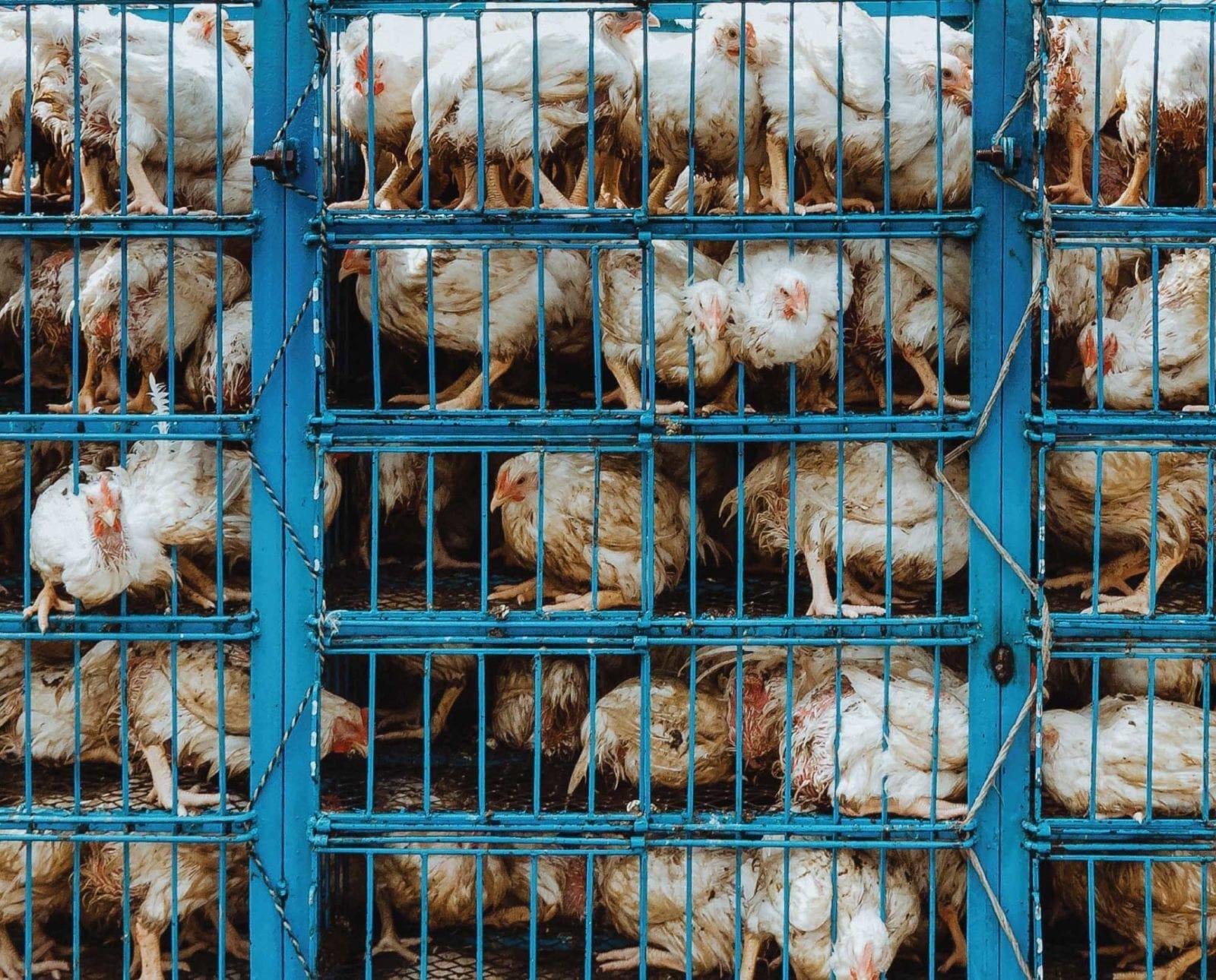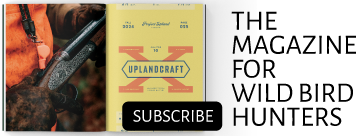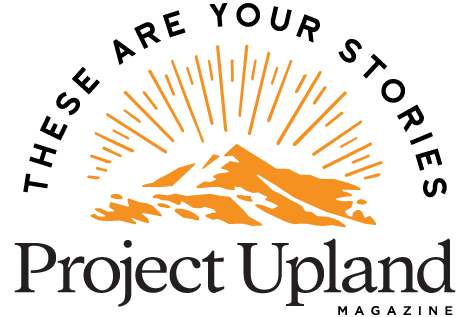Home » Hunting Culture » Why an Animal Lover Gave Up on Industrial Agriculture for Hunting
Why an Animal Lover Gave Up on Industrial Agriculture for Hunting

From saving chickens on the side of the road to becoming a small game hunter
Imagine the sappiest bleeding-heart animal lover you’ve ever met. Got her pictured? Now multiple that by ten and you’ve got me. As a kid on a working Canadian farm, I begged my parents to let me keep the baby mice we found in the baled hay. They escaped their bucket overnight and probably spent the rest of their lives comfortably in the walls of our house, but that didn’t make their rescue any less rewarding to me.
In my twenties, on Washington’s busy Interstate 5, traffic slowed down suddenly for what I soon realized was a truck’s spill of live chickens. Splattered chickens peppered all four lanes, blurs of deep red blood and bright white feathers waving in the breeze of the traffic. Amidst the carnage, one lone survivor was frantically weaving her way between the slowly passing cars and the mashed remains of her cohort. Without thinking, I put my hazard lights on, got out of my car, and tried to chase her down. Turns out scared chickens are pretty darn fast, and when I thought I finally had her cornered, she ducked under the sedan of a family of four. You know that look in someone’s eyes, when you’re looking at them, and they’re looking at you, and you see yourself suddenly through their eyes and you realize the crazy person they’re looking at is you? Needless to say, I got back in my car at that point, sans chicken.
You can see my problem: my first instinct is to save everything. So, it came as something of a surprise when I started seriously considering small game hunting. It didn’t happen overnight. The last five years have led up to this, but it still caught me off guard when I realized I was ready to try it. Two things have been instrumental: my husband, and my education.
I married my husband five years ago this July. When we met, I had never even seen, let alone handled, a gun, and he was an avid, life-long hunter. The story might have ended there, but he made me taco soup with his own venison. A man who brings home the bacon and cooks it? Sold. He soon moved in with me, which meant all his guns were moving in with me, too. I decided that if there were going to be guns in my house, I needed to know how to use them and be comfortable with them. He taught me thoroughly and patiently, with frequent trips to the shooting range.
Every November, he went elk and deer hunting in Montana with his dad, and every year, we had a freezer full of meat that would last us a year. The first elk I tried spoiled me for venison, and the size of the animal meant we had meat for more than a year. Although I had a deep appreciation for the result, I continued to be haunted by the process. I asked him to crop out the bloody holes in the animal when he posed for his picture with his kill to let me know when they’d filled their tags and would be heading home. The butchering was done in Montana, so it always arrived home in neat white packages, the texted photos the only evidence of the bloody deed I was so uncomfortable with.
But eventually, something changed. We bought a small acreage and immediately stocked it with laying chickens, heritage breed piglets, and livestock guardian dogs to watch over them all, convinced we could be modern-day homesteaders. The pigs quickly evolved from “insurance against famine” to very large pets but, as they grew, I guiltily found myself noticing their flesh, with the thought, “This is meat on legs! Just look at all that meat!” However, pigs have an unnerving intelligence that made me feel even more guilty about eating pork than I ever had before. Though never a vegetarian, I had nevertheless walked the uncomfortable line between how I felt about animals (aww!) and how I felt about food (yum….). Choosing to do the uncomfortable, to look more closely at where my food comes from, proved more shocking than I could have predicted.
Denial and euphemisms had served me well, until 2016, when I decided to formalize my life-long interest in public health with a Master’s degree, and promptly found my eyes opened to the undeniable health implications of our modern food system.
Industrialization and globalization have left the food supply vulnerable to disruption and spawned an entire discipline of public health: biosecurity. When you hear the term, you might think of biological weapons, and specifically their use against humans, but a surprising portion of biosecurity’s focus is agriculture and the safety of the food supply from biological disruption.
When an American outbreak of E. coli O157:H7 between September and December of 2019 was linked to romaine lettuce, the entire supply of romaine lettuce vanished, not because of safety but because of availability. Cases of illness occurred in 27 U.S. states, but it turned out that all of the romaine lettuce sold in the entire U.S. in the fall months is grown in one place: the Salinas Valley growing region of California. So, until they could identify which farm or farms had the E. coli outbreak, there was no alternate source of romaine anywhere in the U.S. during that time.
In that same month, September 2019, the world’s largest producer and consumer of pork products, China, culled 100 million pigs to stem an uncontrollable outbreak of African Swine Fever (ASF). That particular virus kills 95% of pigs it infects but is harmless to humans. In Africa, where members of wild swine species are spread far apart over vast spaces, the virus is incapable of wreaking the kind of havoc it unleashes on domestic pigs. In both China and the U.S., industrial pork production involves cramming thousands of animals together in a single enclosed structure, known as concentrated animal feeding operations (CAFOs), in which infectious disease spreads like wildfire. Thus, when African Swine Fever is diagnosed, the only way to stop its spread is “depopulation,” eliminating thousands of tons of potential protein from the global food supply in a matter of days.
China was well aware of this vulnerability, however, and in 2013 multinational Chinese corporation W.H. Group spent $4.7 billion dollars to acquire the largest pork producing company in the U.S.: Virginia-based Smithfield Foods. Not only has African Swine Fever never occurred in North America, but because of lax regulations and aggressive government subsidies of pork production in states like North Carolina and Iowa, it’s actually cheaper for the Chinese to raise pork in those states for sale back in China than to raise pork in China.
So, when African Swine Fever decimated pork populations in China, the global supply of pork took a hit, and prices went up everywhere, even in the U.S., because now North Carolina, Iowa, and Minnesota were supplementing the pork appetites of the world that couldn’t be met that year by China’s supply. It’s important to note that no pigs raised and slaughtered in China are sold here in the U.S.; what’s relevant here is the intense concentration of the entire world’s supply in just a few areas, such that a mass die-off of pigs in China raises pork prices here in the U.S..
If we stay with the pork theme, we are easily led to another implication of so-called factory farming. In Duplin County, North Carolina, pigs outnumber people 30 to 1, and the implications for the health of people in the county are astounding. Pigs produce a mind-boggling amount of waste, and pork producers have to use huge amounts of fresh water to liquefy pig manure in order to manage it in huge manure “lagoons”. Manure lagoons are either poorly regulated or not regulated at all, depending on which U.S. state they’re located in. There are no rules about how they are constructed or managed. They can leak E. coli-laden feces into ground water even at the best of times, but when hurricanes hit, the walls of these structures are often breached by incoming flood waters or eroded entirely by receding flood waters, releasing millions of gallons of infectious slurry into surrounding lowlands, streams, and rivers. The intense influx of nitrogen, among other things, has deadly effects on aquatic species as well.
Even when manure lagoon management goes according to plan, and the manure has been successfully composted in those lagoons to minimize pathogens, human health is still affected. High pressure mist sprayers aerosolize the liquid manure when sprayed onto crop fields as fertilizer, resulting in odors detectable up to five miles away and swine feces DNA detectable in ambient air inside homes up to a mile away. Those who can afford to do so (mostly middle-class white people) move away from these areas. Those left behind are less affluent minorities, many of whom are living on land they inherited from poor share-cropper ancestors that is now devalued because of the local pig farms. They are left to suffer the health effects while politically powerless to advocate for themselves against the wealth and political clout of pork producer associations. Rates of asthma and other respiratory illnesses, among other things, are disproportionately high in communities around these hog farms. This confluence of ecological, social, and health implications is known as environmental racism, but it doesn’t end in Duplin County, North Carolina, or even with hog farming.
Your romaine lettuce comes from Salinas Valley, California. Your oranges come from Florida. Your milk comes from California and Wisconsin. Corn from Iowa or Illinois. Apples from Washington state. Beef from Texas. Chicken from Georgia and Arkansas. While it’s true that some things just grow better in certain areas with the right geographic and climatic qualities, E. Coli and African Swine Fever are just two examples of the consequences of putting all your metaphorical eggs in one basket.
You may have noticed shortages of certain items at the grocery store as a result of global shut-downs to control the coronavirus pandemic. You may have seen headlines about millions of gallons of milk being poured down the drains because there is not enough cold storage to store the amount of milk that our industrial-strength dairy system generates if there’s a dip in consumption, as occurred when restaurants and schools across the nation were closed for weeks, then months. An industrial food system relies not just on farmers, but on a network of truckers to transport the raw product from farms to processing plants, processing and packaging workers, more trucks to get the packaged product to distribution centers, and still more trucks to get the product from those centers to markets where consumers can buy them. There are fewer farmers than ever before but more food system workers, all of whom are paid a pittance in service of a corporate overlord pulling in eye-watering profits from their exploitation of the health of the people and environments they abuse.
Ultimately, my public health education has solidified the lesson that what I choose to eat and how I acquire it are about more than diet, more than my own health. The myth that food happens over here and people live over there must be busted. We cannot escape the consequences of industrial agriculture by concentrating food production in certain areas, out of sight and mind for some but not others, because no such food system is ethical or sustainable. We cannot pretend that hog-feces-tainted air in North Carolina is somebody else’s problem, because as the coronavirus has demonstrated, infectious diseases and pollution don’t respect political boundaries.
Most of all, I cannot pretend that rescuing one loose chicken on the freeway would make up for all the chickens who spent their entire lives in those cages they fell from, never having experienced scratching up an earthworm from healthy soil in bright sunlight. For me, it’s not about animal rights or politics, but about the undeniable fact that the chicken and I are both part of a larger ecology, not separate from it. I would rather consume an animal that had a natural and fulfilling life enriching itself and its natural ecology, because it’s not just the animal who suffers in industrial agriculture: it’s all of us.
So, while our exurban homesteading experiment continues with our perennial vegetable garden and fruit orchard, our meat-eating habits have evolved. While we will still probably harvest an elk from Montana every year, it’s time I contributed to our protein sources with something more local. For my own health, for the health of others, and for the health of our environment, I am compelled to participate in sourcing the food that feeds me in a sustainable way. After five years of being married to a hunter, I’m going to become one myself. I have signed up for Washington’s hunter education program and picked out a mouth-watering recipe for my first target, cottontail rabbits: German Rabbit Stew by Hank Shaw. After all, what could be more local than an animal you shot from your backyard?
If the freeway-chicken-chasing, bleeding heart animal lover can learn to hunt, so can anyone.




Just curious…What happens if EVERYONE hunts small game? Should we reinstate a market hunt so those who can’t afford the time or money to hunt can purchase “locally killed game”? As you probably know, Waterfowl populations rebounded because of conservation of wetlands from development (eg agriculture) AND and end to market hunting. Wild animals alone cannot sustain the amount of people on the planet, neither can small order farming practices, at affordable prices anyway.Maybe donate all your elk meat to those poor people that have to live near hog farms – or to me, an underprivileged country folk living beside potatoe and grain fields and far away from any yummy elk…..I could go on and on, but I don’t have time…good luck with your virtuous bedside hunting.
Great article! I would encourage everyone to share with anti-hunters, vegans, and vegetarians. Hunting is much more humane than many of today’s farming practices. Hunting still might not be for everyone but I think there should be an appreciation and understanding from those who do not.